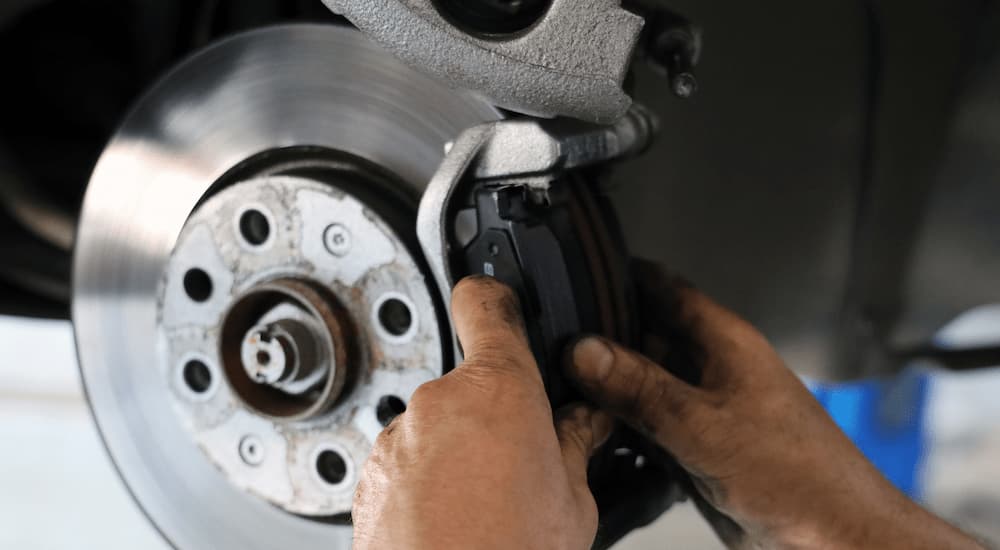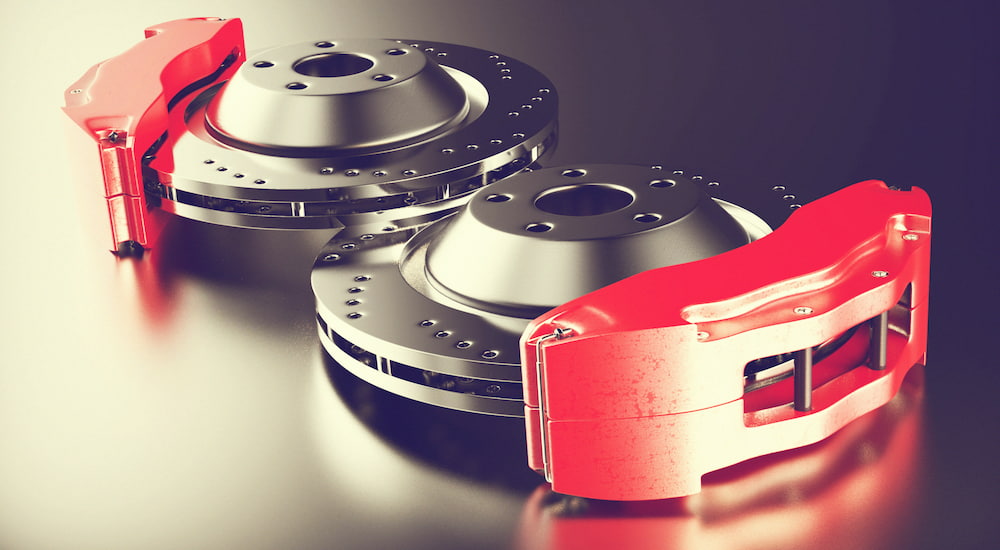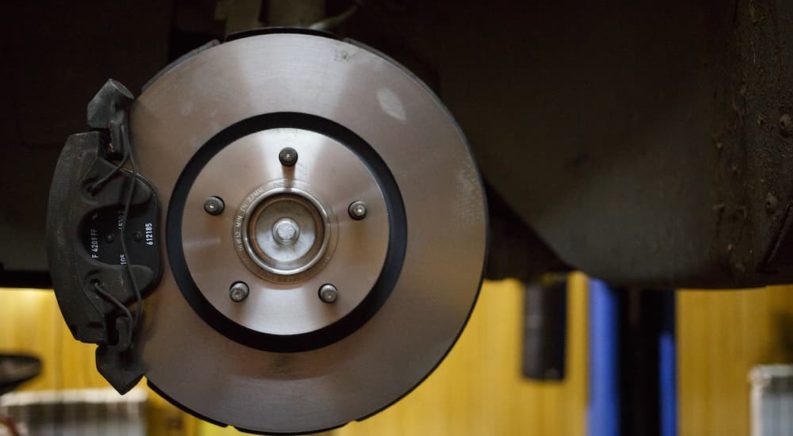Did you know the average American applies their brakes approximately 200 times each day? Whether stopping at a red light or using your brake to reduce your speed, your brakes are critical to your safety behind the wheel and everyone else’s safety on the road. Because of this, finding a reputable team to handle brake repair near you is essential and one of your greatest responsibilities as a vehicle owner.
While applying the brakes is as simple as pressing the brake pedal to bring your vehicle to a stop, there’s far more going on with your vehicle’s brake system than meets the eye. The system relies on dozens of components working together, with brake rotors being one of the most integral parts of it all. But what are brake rotors? What do they do? And how can you tell when it’s time to have them replaced? Let’s find out…

What Are Brake Rotors?
The two types of brakes in the automotive industry are drum brakes and disc brakes. For years, drum brakes were the industry standard because they were inexpensive to manufacture. However, disc brakes have since replaced drum brakes because they are more effective, longer lasting, and better at dissipating heat. This is a critical advantage since bringing your vehicle to a stop requires friction, which generates excessive amounts of heat.
While drum brakes rely on brake shoes and drums at each wheel, disc brakes rely on brake pads and brake rotors. The brake rotors are circular metal discs connected to each wheel. Their job is to use friction to bring your vehicle to a stop. More specifically, they turn the movement of the wheels (kinetic energy) into heat or thermal energy to give you adequate stopping power.
The Big Picture
So, how do the brake rotors work relative to the rest of the braking system in your vehicle? Think of it like a chain reaction that begins when you press the brake pedal. Once engaged, the brake pedal relies on a brake booster to enhance the pressure from your foot because it would otherwise take superhuman strength to stop a moving vehicle. To do this, the pistons in a master cylinder compress brake fluid to create hydraulic pressure, the necessary force to stop your car. However, that’s only the beginning.
The hydraulic pressure moves through the brake lines and hoses, which connect the brake components to the disc brake assembly (caliper, brake pads, and brake rotors) at all four wheels. Once the pressure reaches the brake assemblies, the cylinders at each wheel convert the hydraulic pressure into mechanical force to generate enough friction to stop your vehicle. That friction comes from the brake pads squeezing against the rotors, slowing the car’s wheels.

The Different Types of Rotors
Brake rotors have the same purpose, but they can sometimes look different. For example, there are two broad categories of rotors: solid and vented. Solid rotors are blank and smooth, but vented rotors are subdivided into three categories. They’re either drilled, slotted, or drilled and slotted. So, what’s the difference?
Blank Rotors
Most passenger vehicles are equipped with blank and smooth rotors because they’re inexpensive and effective. These can be solid rotors (usually found on the rear axle) or vented rotors that have small fins between the outer surfaces (usually found on the front axle). The key is always to follow the manufacturer’s recommendation when it’s time to replace your rotors, whether solid or not. Third-party rotors are often more affordable, but that’s because they’re made of lower-quality steel. Unfortunately, they don’t last as long or perform as well, doubling your expenses.
Drilled and Slotted Rotors
Performance rotors fall into three categories: drilled, slotted, and drilled and slotted. Drilled rotors have holes passing from one face to another, reducing weight and helping to prevent gas build up on the rotor face during heavy braking. Slotted rotors achieve the same thing, but take a different approach, swapping drilled holes for slots along the exterior of the metal plate. This is more commonly found on aftermarket rotors, and some argue that slotted rotors are more durable than drilled rotors. Finally, drilled and slotted rotors combine both methods. These are usually the most expensive rotors you can find and are often found on high-performance cars.

Signs You Need New Brake Rotors
Think about how often you rely on your brakes to stop or slow your vehicle. You’re probably using your brakes hundreds of times a day, meaning your brake rotors work overtime to keep you safe on the road. But what happens when they fail? Or, just as important, what factors impact their longevity and effectiveness?
Signs and Symptoms of Bad Brake Rotors
You shouldn’t hear anything when you apply the brakes, meaning strange noises when you engage the brake pedal indicate trouble. Worn brake rotors often make a grinding noise but can also cause the brake pedal to vibrate or pulsate. Either way, it’s critical to have your brakes inspected and share anything you hear or feel from your brakes with the technician.
If left untreated, worn brake rotors can be detrimental to your safety and those around you. As the rotors wear, the brake pads can’t effectively make contact to generate the friction needed to stop your vehicle. Because of this, you may find your brakes aren’t as responsive, forcing you to react sooner and drive more cautiously.
Factors That Impact the Lifespan of Your Brake Rotors
Brake rotors generally last anywhere from 30,000 to 80,000 miles. However, there isn’t a hard and fast rule that determines their longevity. Instead, it comes down to your driving style, the design of the rotors, the type of brake pads, the driving conditions, and environmental elements. Why do so many factors affect their lifespan?
Consider this: driving in town typically involves more braking than highway driving, meaning city driving leads to more wear and tear on your brake pads and brake rotors. Likewise, your driving style also affects the longevity of the brake rotors, with aggressive braking contributing to faster wear. So, while you may not be able to avoid driving in town, you can proactively extend the life of your brake rotors by safely easing off the brakes and being mindful of your driving habits.
Other factors that contribute to the longevity of your brake rotors are their design and the quality of the brake pads. For example, solid rotors are renowned for their longer lifespans, which explains why they’re used on most passenger cars. Alternatively, drilled and slotted rotors don’t last as long because of their design. Moreover, other environmental factors play a critical role, like extreme temperatures or road conditions where salt is used to melt snow.
Know Your Stopping Power
Without brake rotors, your vehicle can’t quickly stop when you engage the brake pedal, which I think you’ll agree is fairly important. It’s a scary situation to imagine pressing your brakes and having them fail to react or even be sluggish, but one that’s realistic if you don’t properly maintain your brakes. Fortunately, brake maintenance isn’t difficult when you understand how the system and components, like the brake rotors, work and what to look for as signs of trouble. From there, proactively maintaining your brakes starts with your awareness while in the driver’s seat and having a reputable automotive team you can trust to handle brake inspections, routine services, and more complex brake-related repairs. Or, if you have the right equipment, you can always get under your car yourself and take a look at your rotors to see if they’re in good shape–just make sure you do it safely and know what to look for.

